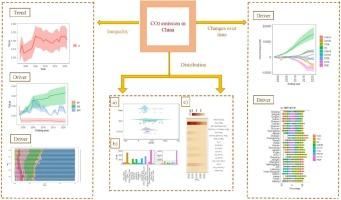Multi-dimensional inequality and energy-carbon technology-related driver of China’s CO2 emission
IF 9.9
1区 工程技术
Q1 ENERGY & FUELS
引用次数: 0
Abstract
As the largest emitter of CO2, China’s decarbonization efforts have garnered increasing global attention. This study aims to investigate the drivers of carbon inequality that refers to which usually refers to CO2 emissions between regions or groups across different energy sources and economic sectors, as well as the heterogeneous drivers of energy-carbon technology (e.g., technological changes in energy use and CO2 emissions). Despite limited attention to these issues, they are crucial for developing effective emission reduction policies for sustainable development. Utilizing the Gini coefficient and production-theoretical decomposition models, we analyze the latest carbon emission inventory of China over 1997–2021, focusing on 17 energy sources and 46 economic sectors. The findings indicate that traditional fossil fuels, such as raw coal, coke, gasoline, and diesel, continue to be the primary contributors to carbon inequality. Production and supply of electric power, steam, and hot water sectors emerge as the largest drivers of carbon inequality among all sectors. Additionally, the potential for energy intensity to reduce emissions has grown increasingly significant, whereas other factors related to efficiency and technology in energy use and CO2 emissions have shown variability over time. This study underscores the importance of developing differentiated emission reduction policies tailored to specific energy sources and economic sectors in China.

中国二氧化碳排放的多维不平等与能源碳技术相关驱动因素
作为全球最大的二氧化碳排放国,中国的去碳化努力日益受到全球关注。本研究旨在调查碳不平等(通常指不同能源和经济部门的地区或群体之间的二氧化碳排放量)的驱动因素,以及能源-碳技术的异质性驱动因素(如能源使用和二氧化碳排放的技术变化)。尽管对这些问题的关注有限,但它们对制定有效的可持续发展减排政策至关重要。利用基尼系数和生产理论分解模型,我们分析了 1997-2021 年中国最新的碳排放清单,重点关注 17 种能源和 46 个经济部门。研究结果表明,原煤、焦炭、汽油和柴油等传统化石燃料仍然是造成碳不平等的主要因素。在所有部门中,电力、蒸汽和热水的生产和供应部门成为碳不平等的最大驱动因素。此外,能源强度的减排潜力日益显著,而与能源使用效率和技术以及二氧化碳排放相关的其他因素则随着时间的推移而变化。本研究强调了针对中国特定能源和经济部门制定差异化减排政策的重要性。
本文章由计算机程序翻译,如有差异,请以英文原文为准。
求助全文
约1分钟内获得全文
求助全文
来源期刊

Energy Conversion and Management
工程技术-力学
CiteScore
19.00
自引率
11.50%
发文量
1304
审稿时长
17 days
期刊介绍:
The journal Energy Conversion and Management provides a forum for publishing original contributions and comprehensive technical review articles of interdisciplinary and original research on all important energy topics.
The topics considered include energy generation, utilization, conversion, storage, transmission, conservation, management and sustainability. These topics typically involve various types of energy such as mechanical, thermal, nuclear, chemical, electromagnetic, magnetic and electric. These energy types cover all known energy resources, including renewable resources (e.g., solar, bio, hydro, wind, geothermal and ocean energy), fossil fuels and nuclear resources.
 求助内容:
求助内容: 应助结果提醒方式:
应助结果提醒方式:


